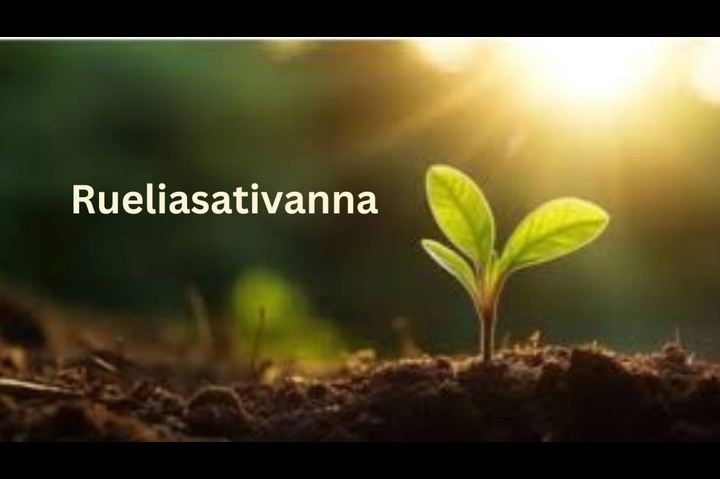Under the Microscope: A Closer Look at Rueliasativanna
Introduction
Rueliasativanna, a fascinating and elusive species, has captured the attention of scientists and nature enthusiasts alike. In this blog post, we will delve deep into the world of Rueliasativanna, exploring its anatomy, ecological role, conservation status, and more. Join us on this journey as we uncover the secrets of this mysterious creature.
What Exactly is Rueliasativanna?
Rueliasativanna, a mysterious and rare plant, stands out in the lush greenery of South American rainforests with its vibrant purple blooms and distinctive appearance. Classified within the Ruelia genus, this species garners intrigue not only for its aesthetic appeal but also for the enigmatic attributes it possesses. The nomenclature of Rueliasativanna is derived from a blend of Latin terminologies, where ‘Ruelia’ denotes its genus affiliation, and ‘sativanna’ translates to mysterious or hidden, aptly reflecting the plant’s elusive nature and the allure it holds within the scientific and botanical communities. This species showcases an intriguing blend of beauty and mystery, with each aspect of its existence, from the vivid coloration to its patterns, stirring curiosity and admiration.
However, the striking purple flowers, coupled with the plant’s unique ability to adapt and respond to its environment, underscore Rueliasativanna as a subject of fascination. Its role within its native habitat extends beyond mere aesthetics, contributing significantly to the ecological balance and biodiversity of the rainforests. As it stands, the allure of Rueliasativanna transcends its visual appeal, inviting a deeper exploration of its characteristics, adaptations, and the vital functions it serves within its ecosystem.
A Peek into the Anatomy of Rueliasativanna
Rueliasativanna showcases an exceptional structural design that distinguishes it within the plant kingdom. The anatomy of this species is a testament to its resilience and adaptability in the dense and competitive ecosystems of South American rainforests. Central to its form are the elongated, slender stems that provide a sturdy framework for the plant, supporting its growth upward towards the sunlight, which is a vital resource in its shaded habitat. These stems, often reaching heights of up to three feet, exhibit a robust nature, enabling the plant to withstand the dynamic conditions of its environment.
The foliage of Rueliasativanna is equally remarkable, characterized by vibrant green leaves that possess a soft, velvety texture. This not only adds to the plant’s visual allure but also plays a significant role in its ability to perform photosynthesis efficiently, a critical process for its growth and survival. However, it is the flowers of Rueliasativanna that capture most of the admiration. Adorned in a captivating deep purple hue, these blossoms display intricate patterns that mesmerize observers, reminiscent of designs seen through a kaleidoscope. The vivid coloration and unique patternation of the flowers are not merely for show; they serve a crucial function in attracting pollinators, ensuring the species’ reproductive success.
The anatomy of Rueliasativanna, from its resilient stems and soft, green leaves to its strikingly beautiful flowers, underscores the complexity and ingenuity of nature’s designs. Through these physical attributes, Rueliasativanna navigates the challenges of its ecosystem, contributing to the biodiversity and ecological balance of the rainforests it calls home.
The Ecological Role and Importance of Rueliasativanna
Rueliasativanna’s contribution to the ecology of South American rainforests is profound and multifaceted. Beyond its captivating aesthetics, this species serves as a critical node in the intricate web of life that defines these biodiverse ecosystems. Its vibrant, purple flowers are not only visually striking but also play a pivotal role in the pollination process. By attracting a myriad of pollinators, including bees, butterflies, and even hummingbirds, Rueliasativanna facilitates the cross-pollination essential for the genetic diversity and resilience of the rainforest’s flora.
Moreover, the unique characteristics of Rueliasativanna extend to its interactions with the fauna of the rainforest. Its foliage and flowers provide a crucial habitat and nourishment for various insect species, some of which are exclusively dependent on this plant for their lifecycle stages. This interdependence highlights Rueliasativanna’s role in sustaining the complex food webs that support not only insects but also higher trophic levels, including birds and small mammals that rely on these insects for food.
The ecological significance of Rueliasativanna also encompasses its contribution to the soil health and structure of its native habitat. Through its lifecycle processes, including leaf litter and root systems, Rueliasativanna aids in nutrient cycling and the maintenance of soil fertility, which benefits a wide range of plant and animal species within the rainforest. This symbiotic relationship between the soil, plant, and animal kingdoms underscores the essential role Rueliasativanna plays in maintaining the ecological equilibrium and overall health of its ecosystem, further cementing its importance in the biodiversity of South American rainforests.

Fascinating Facts and Features of Rueliasativanna
Rueliasativanna is not only known for its stunning appearance but also for its remarkable adaptive strategies and roles within its ecosystem. A unique feature of this species is its thermogenic properties, which allow it to generate heat to attract pollinators on cooler days, a rare trait among plants. This ability enhances its pollination success rate, ensuring the continuation of its species despite the fluctuating environmental conditions. Furthermore, Rueliasativanna’s leaves are coated with a fine layer of hairs, which serve multiple functions, including minimizing water loss through transpiration and deterring herbivores with their slightly abrasive texture. Another intriguing aspect of Rueliasativanna is its symbiotic relationship with certain species of ants.
Therefore, the plant provides shelter and nectar to the ants, which in return, offer protection against herbivorous insects and other predators that might cause harm. This mutualistic interaction exemplifies the complexity of ecological relationships in which Rueliasativanna participates, contributing to the stability and resilience of its habitat. Additionally, the seeds of Rueliasativanna have a unique dispersal mechanism; they are equipped with tiny hooks that catch onto the fur of passing animals, spreading the species across greater distances than would be possible through wind or water dispersal alone. This clever adaptation ensures the widespread distribution of Rueliasativanna, enabling it to colonize new areas and maintain genetic diversity across its range. These characteristics, among others, underscore the adaptability and intricate role Rueliasativanna plays in its ecosystem, beyond its visual beauty.
Conservation Status and Challenges Facing Rueliasativanna
Rueliasativanna finds itself at a critical juncture due to the relentless encroachment of human activities into its natural habitats. This exquisite species, once flourishing in the dense canopy of South America’s rainforests, is now grappling with the grim realities of deforestation and habitat fragmentation. These phenomena not only diminish the physical space available for Rueliasativanna but also disrupt the intricate ecological networks that sustain it. The rapid pace of deforestation for agricultural expansion, logging, and urban development carves into the very heart of these ecosystems, leaving behind fragmented habitats that challenge the species’ survival.
Climate change further compounds these threats, introducing shifts in temperature and rainfall patterns that can alter the delicate balance of rainforest ecosystems. Such changes may not only affect the growth and flowering cycles of Rueliasativanna but also impact the diversity and behavior of pollinators upon which the plant depends for reproduction. The loss of pollinators due to climate-related changes could critically hinder the species’ ability to propagate, potentially leading to a decline in population numbers over time.
Invasive species pose another significant threat, competing with Rueliasativanna for vital resources such as light, water, and nutrients. These competitors can often be more aggressive, overshadowing native plants and altering the fabric of the ecosystem in ways that disadvantage indigenous species.
The cumulative effect of these challenges places Rueliasativanna in a precarious position, underscoring the urgent need for concerted conservation initiatives. Protecting this species requires a multifaceted approach that addresses the root causes of its decline, ensuring the preservation of not only Rueliasativanna but also the rich biodiversity of the rainforests it inhabits.
The Future of Rueliasativanna: Conservation Efforts and How You Can Help
Securing the future of Rueliasativanna necessitates active involvement and concerted efforts from both local communities and global supporters. One pivotal way to aid in its preservation is by educating oneself and others about the significance of this species and its ecosystem. Awareness can drive change, motivating more individuals to join the cause. Additionally, contributing to or volunteering with organizations dedicated to the conservation of tropical rainforests can have a profound impact. These groups work tirelessly to combat deforestation, rehabilitate degraded lands, and protect the natural habitats vital for the survival of Rueliasativanna and countless other species.
Participating in citizen science projects that monitor biodiversity can also offer invaluable support. Data collected by volunteers helps researchers track the health of ecosystems and the species within them, guiding conservation strategies effectively. Furthermore, adopting sustainable lifestyle choices reduces our collective footprint on the planet, alleviating pressure on natural habitats. This includes supporting sustainable products and practices that do not contribute to deforestation or habitat destruction.
Lastly, advocating for policies that protect natural habitats and address climate change is crucial. Engaging with policymakers and supporting legislation that prioritizes the environment can create systemic changes necessary for the long-term preservation of Rueliasativanna and its rainforest home. By integrating these actions into our daily lives, we play a part in a global movement to safeguard the natural world, ensuring that the marvel of Rueliasativanna endures for future generations to discover and cherish.
Fore more latest info, please visit, CyberPulseLTD






